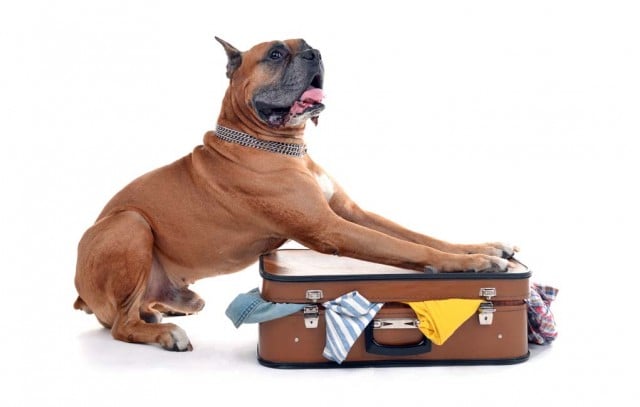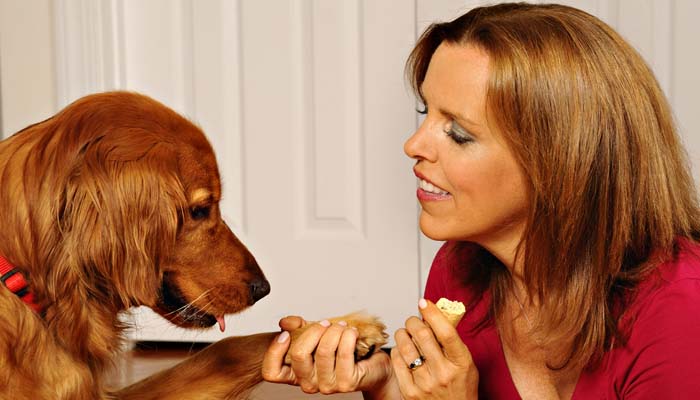
Table of Contents
Want to know how to keep your dog from running away? The best way is to provide your pet with the best home he can possibly have. Dogs aren't like cats and they will not leave a good home for no reason. If this sounds too vague, I do have some actionable tips below on how to keep your dog from running away, especially if this happens on a regular basis.
We all know that most of the time, dogs love being at home with their pet parents. They will even experience uncomfortable separation anxiety when you're not around. There's rarely any reason for a dog to abandon his owner because canines stay loyal to the very end. However, runaway cases do happen as one of the common dog behavior problems, and there's a way to deal with that.
You can keep your dog from running away by making sure your dog is happy at home and rewarding him for not running away. Start training your canine early, be consistent and stay positive. Keeping your dog from running away will be much easier for both of you if you stop or prevent this bad habit before it even begins. However, older dogs who have already acquired a taste for running away can still break the habit.
How to Keep Your Dog From Running Away
1. Great Beginnings
Begin your dog's obedience training while your dog is still a puppy. Obedience training establishes your dominant position which actually makes a dog happy and less likely to run away either when he's a puppy, or when he's older.
Some pet parents choose to train puppies themselves, and there's plenty of ways to do that (see articles below). But you can also take your canine to an obedience class as soon as possible to at least learn the very basics of obedience training.
There are puppy obedience classes for puppies as young as ten to twelve weeks old. Just make sure your pup has had at least two puppy shots. The obedience class will give your young dog good social skills as well as time to socialize with other puppies and people. This alone will reduce his desire to part ways, keep your dog from running away and socialize in the neighborhood.
Here are a few good posts on training young puppies:
- 10 Psychological Tricks To Train Your Dog
- Puppy Training 101: Basic Walkthrough
- How to Train a Puppy in 3 Simple Steps
- How to House Train a Dog for Free
- How to Train a Puppy?
2. Respect the Door
 One of the tricks that will help you to keep your dog from running away is to teach your puppy to go through an open door only after you go through it first and/or give him permission to go through the door so he learns that slipping out the door and running away is not allowed.
One of the tricks that will help you to keep your dog from running away is to teach your puppy to go through an open door only after you go through it first and/or give him permission to go through the door so he learns that slipping out the door and running away is not allowed.
Here's how you can quickly train your dog to do that:
- Put your dog on a leash, make him sit, open the door and tell him no when he gets up to go through the door. Make him sit again and open the door again.
- Walk through the door first then invite him to follow only after he remains sitting while you open the door. Do not let him rush past you.
- Once he successfully accomplishes what you have requested from him, reward your dog with a tasty dog treat as soon as he has done the “technique” correctly.
This is an ongoing process, and it's always tough in the very beginning. Most pet parents are often advised by dog trainers to stick with it, be very patient and consistent. It's the only way you can train your dog in general.
You can also continue this “doggy door training” by going outdoors without your dog then rewarding him when you come back indoors if he does not try to go through the door without permission. Take this training even further by making the dog sit a safe distance from the door when you open it to let visitors in, talk to a neighbor or accept packages.
3. Reward Coming Home
Using positive reinforcement training alongside operant conditioning is the best way to learn how to keep your dog from running away. During the training process, reward your puppy whenever he comes back indoors after doing his potty business outdoors. This will make it enjoyable for the dog to come home, which will help keep your puppy from running away from home.
Positive reinforcement has been proven as the most effective method of dog training. Remember to always reward your dog with his favorite dog treat whether you take your dog outdoors on a leash or have a fenced yard for him to walk around in freely.
Housebreaking methods can also help to keep your dog from running away as they train your dog obedience and house rules. As soon as you have adopted a puppy, you will probably have to housebreak him first, so add the above obedience training techniques into your daily training routine and you should be fine in the long run. Below are some articles on helping you to housebreak a dog effectively.
- How to Housebreak a Puppy Effectively
- How to House Train a Dog for Free
- Grass Litter Boxes vs Housebreaking Training Pads
4. Remove a Strong Motivator
There's always a reason why dogs keep running away from home, and one of those reasons is their natural animal instincts. One of the ways to keep your dog from running away is to have your canine spayed or neutered to eliminate this motivation and keep your dog from running away in order to make more puppies.
Spaying and neutering should be done by the time your dog is six months old. Dogs often reach sexual maturity at that age and then they are off to procreate. This can be an expensive procedure but there are low-cost spay/neuter programs throughout the United States.
5. Controlled Neighborhood Exploration
 Dogs are naturally curious animals. If you have a young puppy, then he's probably ten times more curious than an adult dog. The point here is that canines instinctively want to know what's going on in the world, and their strong sense of smell will often lead them in all kinds of trouble.
Dogs are naturally curious animals. If you have a young puppy, then he's probably ten times more curious than an adult dog. The point here is that canines instinctively want to know what's going on in the world, and their strong sense of smell will often lead them in all kinds of trouble.
If you want to keep your dog from running away, make sure to take longer walks every day to keep your dog from running away. Taking these long walks that stretch beyond your backyard helps to satisfy your dog’s curiosity about the world, and familiarizes the dog with your neighborhood.
Here are some tips on taking these walks with a dog in order to keep him from constantly running away from home:
- Start the walk with your dog in a heal position or walking next to you with his head even with your legs. This position reinforces your dominance and reminds him that he has to obey you.
- Use tasty dog treats to reward him for walking at your heal until he gets the idea. After that, a simple “good boy” and a little petting will be enough of a reward.
- Take your pet to a dog park to let him off leash to play, socialize with other dogs. If you live in a decent size American city, there's usually a dog park somewhere within a walking distance.
- Bring a long rope or a retractable dog leash with you, walk him to a park or even an empty lot nearby, put the long dog leash on him and tell him it is okay to put his nose to the ground and explore as he pleases. Walk your dog on a 3- to 4-foot long leash for better control until you get to the dog park or empty lot.
Here are a few posts on the best dog leash for walking your pet and other relevant advice:
6. Further Dog Training
Whether your dog keeps running away or not, obedience training is an important part of canine ownership. If you don't live alone in some rural area, you need to always be in control of your dog in case something happens, thus as soon as you adopt a puppy, prioritize his training.
Once you've gone through the dog obedience training basics, continue training your Fido to come to you when called to keep your dog from running away in case you ever drop the leash, your dog gets spooked or something else happens. This very important part of obedience training starts in a professional obedience class. It is up to you to continue “in the field.”
Try doing it this way:
- Take your dog’s favorite treat with you when you are going to do long-leash work.
- Let him walk away from you until he is at the end of his long leash.
- Call him to you while he is intent on smelling something good then reward him with a treat.
- Hold your dog in your arms for a minute or two then send him off to continue exploring with an “okay, go!” command.
Do not let your dog off his long leash until you are absolutely certain he will always come when called. Some dogs never really reach this point, so be mindful of this fact. Those are the dogs that should never be allowed off the long leash, no matter how much you'd like to let your pooch go free. Below are some tips on training your dog that you'll find useful.
- Confusion About Negative Reinforcement During Dog Training
- How to Deal With Dog Aggression Without Training Collars
- High Frequency Training: How to Use Dog Whistles
- No More Pain: Best Alternatives to Dog Shock Collars
7. Happy at Home
 It's important to understand that if you want to keep your dog from running away, you must first provide him with a good home. It's actually very rare for dogs to run away from home for no reason, thus if this keeps happening to you, examine the situation from all angles and ensure that your canine is happy at your home.
It's important to understand that if you want to keep your dog from running away, you must first provide him with a good home. It's actually very rare for dogs to run away from home for no reason, thus if this keeps happening to you, examine the situation from all angles and ensure that your canine is happy at your home.
Pet parents can always make staying at home more pleasant for their dogs to keep them from running away. Give your canine a comfortable place to sleep with a comfortable dog bed. A good doggy bed with some cushion is best, but if you want to avoid spending money, then a thick blanket will also make for a good dog bed.
Always keep your dog's bed clean and dry. A clean, dry bed is less likely to harbor pests like fleas and other parasites, and is much more enjoyable for your dog to lay on. You'd be surprised how much dogs love their beds!
Additionally, you can ensure your dog receives a few other perks by living in your home. If you're not on a tight budget, then spoiling your pooch with some dog supplies will help to keep your dog from running away. This includes things like a soft dog crate that your canine will consider “his own home,” and a few other dog products that I'll mention below.
- How to Ensure a Good Night’s Sleep for Puppies
- Best Extra Large Dog Crates
- Best Soft Sided Dog Crate
- Adopting a Puppy? You Will Need These Puppy Training Supplies
8. Doggy Play Time
Dogs are social, active animals. They love to play and entertain themselves, and depending on the breed, some canines may require a huge amount of exercise and play time every single day. Hopefully you have researched your dog breed before adopting, and you're aware how much time you need to spend with your dog just playing.
Carve out some play time every day to help keep your dog from running away. Play time burns off your canine's energy that would otherwise make it more difficult for your pooch to resist running away. Do this in addition to your daily walks. Both activities use up excess energy but also serve different purposes.
Playing at home with your dog makes staying in your house more fun for the pup than running away. If you have to leave home to go to work every day, set aside at least 20 minutes of play time with your pet before you leave and go for a walk when you get home.
A little additional play time after the walk is a good idea for a high-energy dog that requires a bit more exercise to reduce his energy level and the temptation to run away. Providing your pooch with his own dog house is a big deal for him. Dog toys that can help with this as well, and I'll touch upon this later.
FULL GUIDE: How To Stop A Dog From Pulling – Step-By-Step Instructions
Safe and Secure at Home
 In addition (not instead) to all the above methods, you can also put your dog in a secure area to keep him from running away while you are not home.
In addition (not instead) to all the above methods, you can also put your dog in a secure area to keep him from running away while you are not home.
Many dogs love to be outdoors while their humans are away from home, which is when exercise pens for dogs are very handy.
A completely enclosed area with fence on all sides is the best way to keep your dog from running away from home while you are not there. Make absolutely certain your dog’s enclosure is escape-proof before trying to leave him in it while you are gone. Pet gates for dogs, dog playpens or pet exercise pens (the same ones we use with toddlers) usually work best for this. You can also use pet gates for dogs the same way.
Speaking of dog outdoor fences, here are a few tips:
- The fence must go all the way to the ground or even a few inches below the soil if your dog likes to dig.
- The fence must be tall enough to keep your dog from escaping over the top.
- The door to the pen must be firmly secured at the center and bottom. Dogs can push the bottom corner of the door or gate open, squeeze though and go on a merry romp of the neighborhood easier than you may think.
Unfortunately, there are dogs who are natural escape artists. It seems as though there is nothing you can do to keep them in an enclosure. Some owners opt for using shock collars with their dogs, and others go for invisible dog fences, but both of these methods have been known as very controversial. There are better methods to keep your dog from running away, and you should take a look at the below articles for perfect alternatives.
Dogs like that need to be kept indoors in a crate or exercise pen while you are away. It is much safer for your pet. So here are some articles on how to keep your dog safe and secure using fences, pet gates and exercise pens:
- 15 Reasons to Consider Pet Safety Gates for Your Dog
- Playtime Protectors: Dog Playpens or Pet Gates?
- Best Non-Harmful Alternatives to Electric Dog Fences
- Pros & Cons of Wireless Dog Containment Systems
- How to Choose Dog Gates and Playpens for Dogs
- Safe Playtime: Why You Should Consider a Playpen for Dogs
Keep Your Dog Entertained
Reliable, interesting, interactive and long-lasting dog toys help alleviate boredom in puppies and adult dogs, which can help keep your dog from running away. Some of the best chew toys for dogs are good but dog owners need to be very cautious with these dog toys.
For example, rawhide dog chews can cause digestive problems or get caught in the dog’s throat when he tries to swallow the last piece. Pet parents need to only buy safe dog chews and doggy chew toys that are tough enough to stand up to your dog. KONG toys have been proven as the best way for keeping dogs occupied.
The best way to keep your puppies occupied using KONG toys is the way I described in this article: buy a few KONG dog toys, fill these toys with safe-for-dogs peanut butter or natural cream cheese, put them in the freezer and give one of them to your pooch to keep him occupied.
When using treat dispensing dog toys like those from KONG, your dog will be kept busy for hours trying to lick the frozen peanut butter or cream cheese out of the hollow, rubber KONG toy. Plush squeaky toys are good for smaller dogs that will not get aggressive with them. They should not be given to dogs that quickly rip the plush covering off to get at the squeaker.
Here's a few quick articles on how to choose the perfect dog toy to keep your dog from running away, and which ones are the best:
- The Best Dog Toy
- Being Choosy About Dog Toys
- 25 Best Puppy Toys for Dogs that Chew A Lot
- How to Choose the Right Dog Toys by Age
- Durable Dog Toys That Will Outlast Your Puppy’s Jaws
FULL GUIDE: How To Train A Dog To Walk On A Leash
Want more interesting and actionable doggy tips for pet parents? Then remember to subscribe to our YouTube channel for DAILY videos with all things dogs and owners.

















